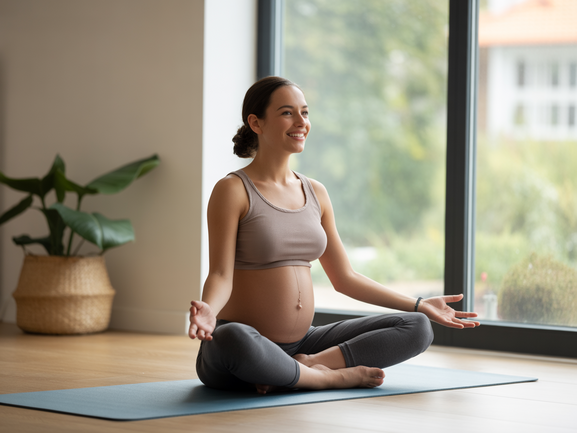Prenatal Yoga: Safe Movement for Pregnancy & Postpartum Recovery
The journey of motherhood brings incredible transformations to your body and mind. Whether you’re expecting your first child or navigating the postpartum period, your body deserves gentle, nurturing movement that honors these changes. Prenatal yoga offers a beautiful way to stay connected with your body while providing essential support during this sacred time.
At Vitalizen.app, we understand that every woman’s pregnancy and recovery journey is unique. That’s why we’ve created specialized programs that adapt to your changing needs throughout each trimester and beyond.
Why Prenatal Yoga is Essential for Expecting Mothers
During pregnancy, your body undergoes remarkable changes that can create physical discomfort and emotional stress. Yoga for pregnant women addresses these challenges through gentle, targeted movements that provide both immediate relief and long-term benefits.
Physical Benefits During Pregnancy
- Lower back pain relief: Gentle spinal movements and hip openers reduce pressure on the lower back
- Improved posture: Strengthening exercises counteract the forward pull of a growing belly
- Better sleep quality: Relaxation techniques and gentle stretches prepare your body for rest
- Reduced swelling: Circulation-boosting poses help minimize fluid retention
- Pelvic floor preparation: Targeted exercises strengthen muscles for labor and delivery
Mental and Emotional Wellness
Beyond physical benefits, prenatal wellness encompasses mental health support. Regular yoga practice helps manage pregnancy anxiety, promotes emotional balance, and creates a deeper connection with your growing baby.
Common Questions About Prenatal Yoga
Is it safe to practice yoga during pregnancy?
Yes, safe pregnancy exercises include modified yoga poses designed specifically for expecting mothers. However, always consult your healthcare provider before beginning any exercise program during pregnancy.
Which movements should I avoid during each trimester?
Avoid deep backbends, prone positions (lying on stomach), intense twists, and inverted poses. After the first trimester, limit supine positions (lying on back) to prevent pressure on major blood vessels.
Postpartum Yoga: Supporting Your Recovery Journey
The postpartum period requires gentle reintegration of movement. Postpartum yoga focuses on healing, rebuilding core strength, and addressing the unique physical challenges new mothers face.
Recovery-Focused Benefits
- Core rehabilitation: Gentle exercises help restore abdominal muscle function
- Shoulder and neck tension relief: Counteracts the strain from feeding and carrying your baby
- Emotional support: Provides mental health benefits during a time of significant adjustment
- Energy restoration: Restorative poses help combat new-parent fatigue
When can I resume exercise after giving birth?
Most healthcare providers recommend waiting 6-8 weeks after vaginal delivery and 8-12 weeks after C-section before resuming exercise. Start with gentle postpartum recovery movements and gradually progress as your body heals.
Essential Safe Movement Practices
For Pregnancy (All Trimesters)
1. Cat-Cow Pose (Modified)
This gentle spinal movement relieves lower back tension and promotes flexibility. Position yourself on hands and knees, alternating between arching and rounding your spine with each breath.
2. Prenatal Child’s Pose
Widen your knees to accommodate your growing belly. This restorative pose calms the nervous system and gently stretches the back muscles.
3. Wall-Supported Warrior II
Using a wall for support, this strengthening pose builds leg endurance while maintaining balance as your center of gravity shifts.
For Postpartum Recovery
4. Gentle Bridge Pose
Lying on your back with knees bent, lift your hips gently. This pose strengthens the glutes and helps restore pelvic alignment.
5. Seated Spinal Twist
Gentle twisting movements help release tension in the back and improve spinal mobility after months of postural changes.
6. Legs-Up-the-Wall Pose
This restorative inversion reduces swelling in legs and feet while promoting deep relaxation.
Safety Precautions and Professional Guidance
While pregnancy movement offers numerous benefits, certain precautions ensure both mother and baby’s safety:
- Always warm up before practicing and cool down afterward
- Stay hydrated and avoid overheating
- Listen to your body and modify poses as needed
- Stop immediately if you experience dizziness, shortness of breath, or pain
For comprehensive guidance, consider working with certified prenatal yoga instructors who understand the anatomical changes during pregnancy and postpartum recovery. External resources like the American College of Obstetricians and Gynecologists provide additional safety guidelines.
Creating Your Personal Practice
Building a consistent maternal health routine supports your wellbeing throughout pregnancy and recovery. Remember to:
- Practice at a time when you feel most energized
- Create a calm, quiet space for your practice
- Use props like blocks and bolsters for support
- Connect with your breath and move mindfully
Your pregnancy and postpartum journey is unique. Honor your body’s wisdom and embrace the transformative power of mindful movement.

